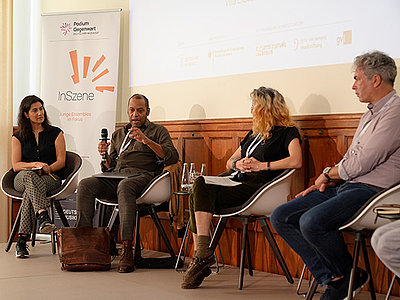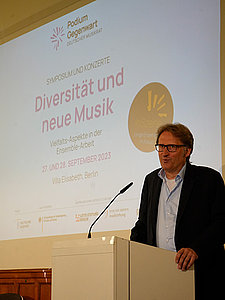Musical innovation today
Contemporary music ensembles in focus - by Bastian Zimmermann
For 70 years now, the German Music Council, the largest national umbrella organization, has shaped music culture in Germany. One of the most important innovations in recent years has been the promotion of young ensembles, if you like, the musical-artistic middle class. What drives these young musicians to come together in ensembles? What does this mean in terms of cultural policy? On September 27 and 28 of this year, numerous representatives from politics, the music industry and ensembles met at the Villa Elisabeth in Berlin to explore the question of diversity in music, particularly in the ensemble landscape. And indeed: Ensembles are the predestined place for musical innovation in contemporary art music.
I would like to start my impulse from my biography as a writer, dramaturge and curator and then move on to a more general point. Almost 15 years ago, I started my career as a freelancer in Frankfurt am Main and wrote a lot about music for various magazines, but also worked dramaturgically in musical-performative contexts. And back then I kept asking myself where the places were where something artistic could take place, where something new could be developed. For me as a young student, there were either established, even large institutions that knew how they worked and let experimentation and innovation hang out as a brand...and then there were unfunded subcultural or student projects that could be exciting and innovative, but were not realistic for a freelancer to survive.
Berlin was also the place in Germany back then where there was more. There were ensembles in the reasonably well-financed middle class that could develop individual projects quite flexibly. In the other cities in Germany, back then, there was almost nothing.
Today, 15 years later, things are different. There is a really exciting ensemble landscape right across Germany's cities and with ensembles that function differently to the big ones.
What are ensembles? They are groups of people who organize themselves together, who perhaps organize themselves differently, who come together out of social contexts. And therein lies the great potential for the question of diversity in the contemporary music landscape. In contrast to established structures, they find their own specific aesthetics and forms of organization as a group. To put it simply: they implement what they might miss elsewhere. I would go on to say that the young contemporary ensemble landscape is something of a hub for diverse art production - on the level of performers, what is performed and production methods. At the conference, someone said: "A trio is three instruments, but it is also three people.
The fact that there is such a variety of ensembles today is also for the simple reason that there has been funding for them for some years now. However, it is important that the working structures established by these funds also allow for continuity.
Ensembles with new aesthetics and production methods also challenge the funding institutions. There are lessons to be learned from this. Because: Who falls out of the funding schemes and how? Which networks and infrastructures must be established by the artists in order to be recognized by the major sponsors?
Let me give you an example. The soloist ensemble Kaleidoskop in Berlin are the pioneers in the field of music ensembles, who have dedicated themselves to inter- and transdisciplinary performative work since their beginnings. In short: they have never played a conventional concert, or perhaps one with a twinkle in their eye. This also means that they develop projects differently: they rehearse for weeks, rather like in the theater, doing physical and choreographic work and avoiding the classic performance logic of commission, score and performance with two days of rehearsal. There is no performance convention for the members of the Kaleidoskop soloist ensemble. As the name suggests, it is also an ensemble of soloists who each have their own ideas, which they then realize in self-directed projects. Or they invite guest directors, choreographers, composers etc. to develop and realize their ideas together with them.
In almost 15 years, the ensemble's existence has been in constant flux, sometimes under threat, and it has certainly been called into question time and again from various sides of the various businesses, especially music. I also know those music people in cultural offices who say that if the violin rises from the score and spins around in circles, then it's no longer music.
But music can be so many things. First and foremost, music is a communicative medium with which I interact with other people. My body produces sounds through movement, even animals do that. But I can also pick up the laptop. However I and the others come to an artistic result is open. How it manifests itself as a show or situation is also open! And in the end, a huge network of actors decides whether an aesthetic is popular, whether it develops further...or not.
That's the potential of these young ensembles, they provoke questions, good questions: So what would a garage band of new music be? In other words, a group of musicians who meet in a garage without funding to hang out and develop things together. Is that even conceivable with the current conventions?
Which ultimately leads to the question I'd like to finish with: What kind of careers are possible in the field of contemporary music? Does every musician and composer who somehow receives public funding for their projects have to have studied? And if they have done so: What is the repertoire that musicians and composers are taught at conservatoires? Here too, change is slowly in sight. However, these moments of change have to be tested somewhere. And the ensembles are precisely this playing and testing space for a more diverse artistic and musical practice.


